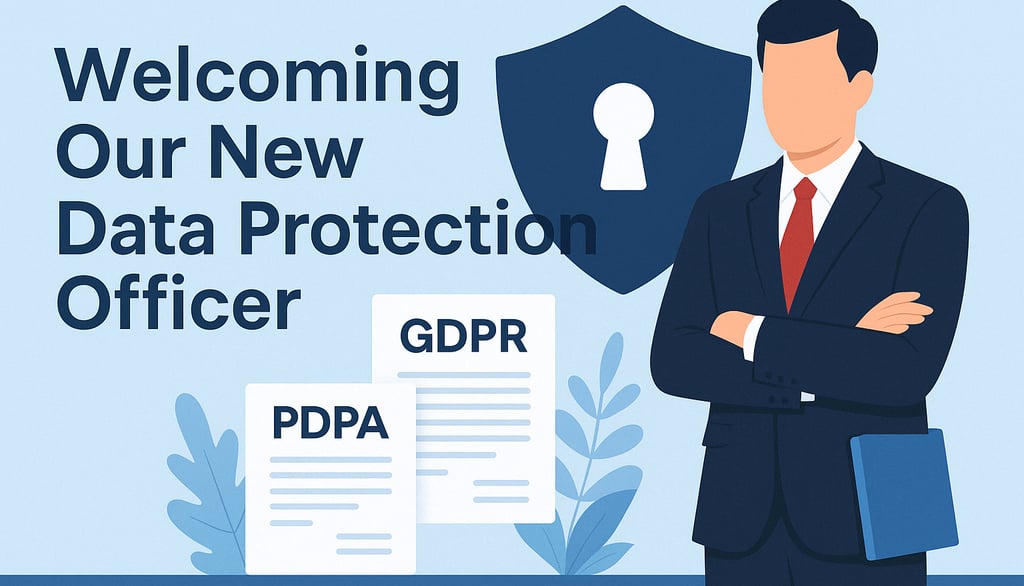A Guide for Newly Appointed Data Protection Officers (DPOs): Navigating PDPA and GDPR Compliance
5/24/20253 min read


In today’s increasingly data-driven world, the role of a Data Protection Officer (DPO) is critical. As a newly appointed DPO, you are tasked with safeguarding sensitive information, ensuring compliance with regulations, and fostering trust among stakeholders. This article outlines key responsibilities and practical steps for DPOs, with specific references to Singapore’s Personal Data Protection Act (PDPA) and the European Union’s General Data Protection Regulation (GDPR).
Understanding the Role of a DPO
A DPO serves as the cornerstone of a company’s data protection strategy. Under both the PDPA and GDPR, the role involves:
Overseeing Data Protection Compliance: Ensuring that the organisation adheres to data protection laws and regulations.
Advisory Role: Providing guidance to employees and management on best practices for handling personal data.
Conducting Audits: Regularly reviewing and auditing the organisation’s data protection policies and practices.
Liaising with Authorities: Acting as the point of contact for data protection authorities, such as Singapore’s Personal Data Protection Commission (PDPC) or the EU’s supervisory authorities.
Key Responsibilities Under PDPA and GDPR
Compliance with Legal Frameworks
PDPA (Singapore): The PDPA governs the collection, use, disclosure, and care of personal data in Singapore. Key obligations include:
Obtaining consent before collecting personal data.
Notifying individuals of the purposes for data collection.
Ensuring appropriate security measures to protect data.
GDPR (EU): The GDPR stipulates broader and stricter compliance requirements, including:
Data subject rights (e.g., right to access, rectify, and erase data).
Maintaining records of processing activities (Article 30).
Reporting data breaches to authorities within 72 hours (Article 33).
Data Protection Impact Assessments (DPIAs)
Under GDPR, DPIAs are mandatory for high-risk data processing activities (Article 35).
While not explicitly required under PDPA, conducting regular risk assessments is a best practice to identify and mitigate risks.
Training and Awareness
Educate employees on data protection principles and their responsibilities under PDPA and GDPR.
Conduct workshops and training sessions to ensure compliance across the organisation.
Data Breach Management
Both PDPA and GDPR require organisations to implement processes for identifying, reporting, and managing data breaches.
Under PDPA, breaches likely to cause significant harm must be reported to the PDPC and affected individuals.
GDPR requires reporting breaches to the supervisory authority and affected parties when necessary.
Practical Steps for a New DPO
1. Familiarize Yourself with Regulations
Read the full text of the PDPA and GDPR along with the guidelines provided by the PDPC and the European Data Protection Board (EDPB).
2. Conduct a Data Audit
Map out the personal data your organisation collects, processes, and stores.
Identify gaps in compliance and prioritize areas for improvement.
3. Develop a Data Protection Management Program (DPMP)
The PDPC recommends creating a DPMP to demonstrate accountability.
Include policies, procedures, and practices for managing personal data.
4. Establish Clear Policies
Implement policies on data retention, processing, and breach notification.
Ensure these policies are aligned with both PDPA and GDPR requirements.
5. Implement Technological Safeguards
Use encryption, access controls, and other security measures to protect personal data.
Regularly review and update IT systems to address vulnerabilities.
Recommended Resources for DPOs
· Personal Data Protection Act (PDPA): PDPC Website
· General Data Protection Regulation (GDPR): EU GDPR Portal
· PDPC Guide on Data Protection Management Program: Download Here
· EDPB Guidelines and Recommendations: Visit EDPB
Tracking Progress and Continuous Improvement
To excel in your role, it’s essential to monitor and evaluate your efforts. Consider these steps:
Maintain a Compliance Log: Document activities, audits, and breach reports to demonstrate accountability.
Engage Stakeholders: Regularly update management and employees on data protection initiatives.
Leverage Technology: Use tools to track compliance efforts and automate repetitive tasks.
Conclusion
As a newly appointed DPO, your role is pivotal in ensuring that your organisation complies with PDPA and GDPR requirements. By adopting a proactive approach, leveraging best practices, and staying informed, you can effectively safeguard personal data and build trust with employees, customers, and stakeholders.
If you’re feeling overwhelmed, remember that you are not alone. Resources, communities, and experts are available to support you on your journey.
oneorve
Integrity. Sustainability. Impact.
© 2025 ONEORVE PTE. LTD. All rights reserved.




